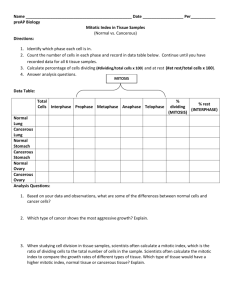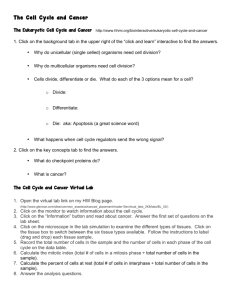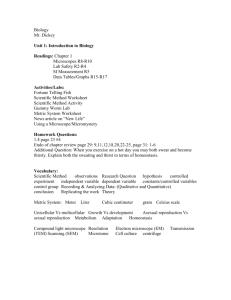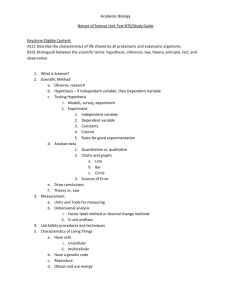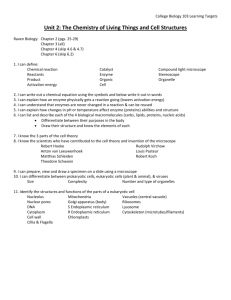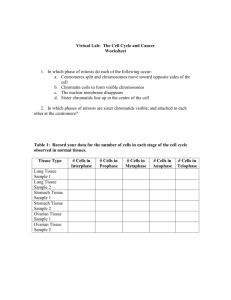HOW CAN CANCER CELLS BE RECOGNIZED?
advertisement
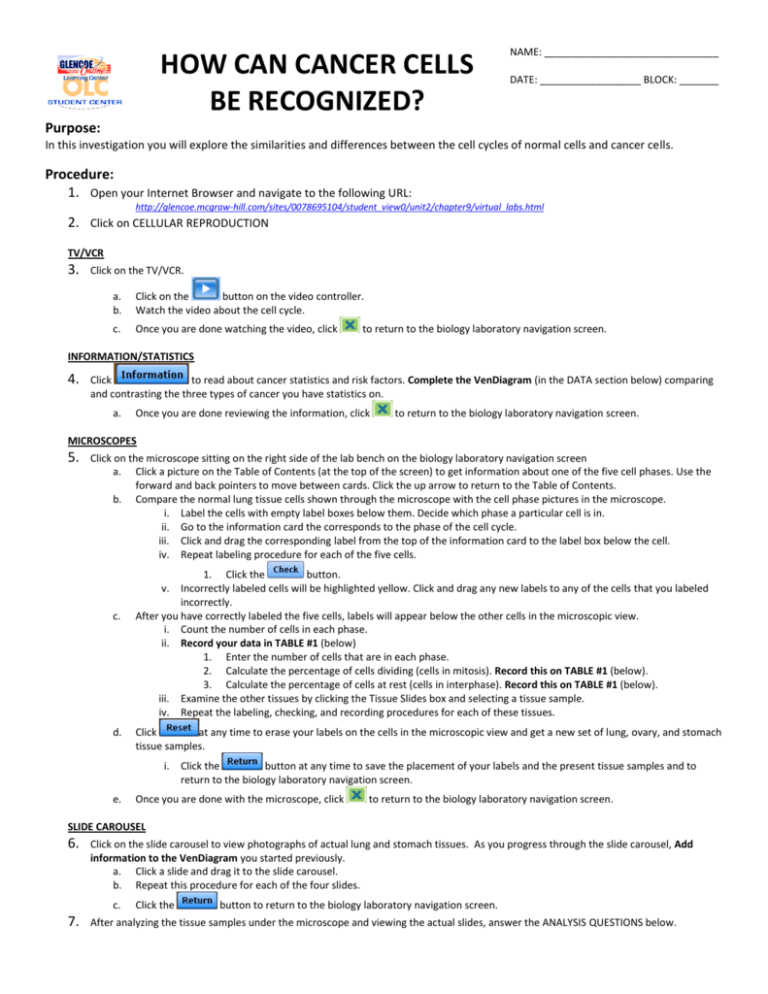
HOW CAN CANCER CELLS BE RECOGNIZED? NAME: _______________________________ DATE: __________________ BLOCK: _______ Purpose: In this investigation you will explore the similarities and differences between the cell cycles of normal cells and cancer cells. Procedure: 1. Open your Internet Browser and navigate to the following URL: http://glencoe.mcgraw-hill.com/sites/0078695104/student_view0/unit2/chapter9/virtual_labs.html 2. Click on CELLULAR REPRODUCTION TV/VCR 3. Click on the TV/VCR. a. b. Click on the button on the video controller. Watch the video about the cell cycle. c. Once you are done watching the video, click to return to the biology laboratory navigation screen. INFORMATION/STATISTICS 4. Click to read about cancer statistics and risk factors. Complete the VenDiagram (in the DATA section below) comparing and contrasting the three types of cancer you have statistics on. a. Once you are done reviewing the information, click to return to the biology laboratory navigation screen. MICROSCOPES 5. Click on the microscope sitting on the right side of the lab bench on the biology laboratory navigation screen a. Click a picture on the Table of Contents (at the top of the screen) to get information about one of the five cell phases. Use the forward and back pointers to move between cards. Click the up arrow to return to the Table of Contents. b. Compare the normal lung tissue cells shown through the microscope with the cell phase pictures in the microscope. i. Label the cells with empty label boxes below them. Decide which phase a particular cell is in. ii. Go to the information card the corresponds to the phase of the cell cycle. iii. Click and drag the corresponding label from the top of the information card to the label box below the cell. iv. Repeat labeling procedure for each of the five cells. 1. Click the button. Incorrectly labeled cells will be highlighted yellow. Click and drag any new labels to any of the cells that you labeled incorrectly. After you have correctly labeled the five cells, labels will appear below the other cells in the microscopic view. i. Count the number of cells in each phase. ii. Record your data in TABLE #1 (below) 1. Enter the number of cells that are in each phase. 2. Calculate the percentage of cells dividing (cells in mitosis). Record this on TABLE #1 (below). 3. Calculate the percentage of cells at rest (cells in interphase). Record this on TABLE #1 (below). iii. Examine the other tissues by clicking the Tissue Slides box and selecting a tissue sample. iv. Repeat the labeling, checking, and recording procedures for each of these tissues. v. c. d. Click at any time to erase your labels on the cells in the microscopic view and get a new set of lung, ovary, and stomach tissue samples. i. e. Click the button at any time to save the placement of your labels and the present tissue samples and to return to the biology laboratory navigation screen. Once you are done with the microscope, click to return to the biology laboratory navigation screen. SLIDE CAROUSEL 6. Click on the slide carousel to view photographs of actual lung and stomach tissues. As you progress through the slide carousel, Add information to the VenDiagram you started previously. a. Click a slide and drag it to the slide carousel. b. Repeat this procedure for each of the four slides. 7. After analyzing the tissue samples under the microscope and viewing the actual slides, answer the ANALYSIS QUESTIONS below. c. Click the button to return to the biology laboratory navigation screen. HOW CAN CANCER CELLS BE RECOGNIZED? NAME: _______________________________ DATE: __________________ BLOCK: _______ DATA: TABLE #1 INTERPHASE PROPHASE METAPHASE ANAPHASE TELOPHASE % of cells dividing % of cells at rest Normal Lung Cancerous Lungs Normal Stomach Cancerous Stomach Normal Ovary Cancerous Ovary ANALYSIS QUESTIONS: 1. Based on your data and observations, what are FOUR differences between normal cells and cancer cells? ______________________________________________________ ______________________________________________________ 3. When studying cell division in tissue samples, scientists often calculate a mitotic index, which Is the ration of dividing cells to the total number of cells in the sample. Scientists often calculate the mitotic index to compare the growth rates of different types of tissue. Which type of tissue would have a higher mitotic index: normal tissue or cancerous tissue? EXPLAIN. ______________________________________________________ ______________________________________________________ ______________________________________________________ ______________________________________________________ 2. Which type of cancer shows the most aggressive growth? EXPLAIN. ______________________________________________________ ______________________________________________________ ______________________________________________________ ______________________________________________________ ______________________________________________________ ______________________________________________________ ______________________________________________________ ______________________________________________________ ______________________________________________________ ______________________________________________________ ______________________________________________________ ______________________________________________________ ______________________________________________________ ______________________________________________________


